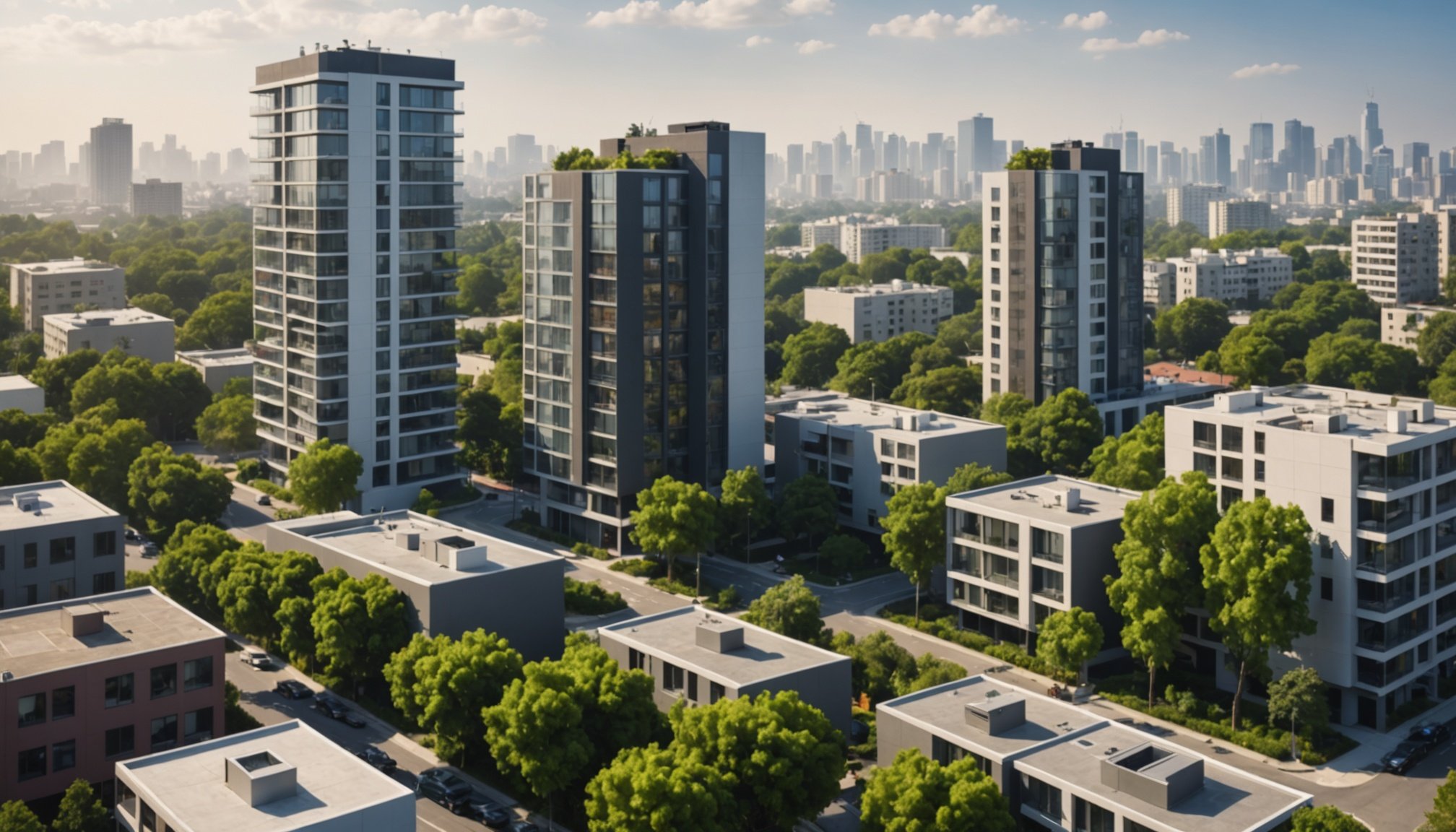Overview of Air Quality Challenges in Urban Areas
Urban pollution poses a significant risk to air quality, especially in dense residential zones. Rapid urbanization and industrial activities contribute substantially to air pollution, leading to various health risks. Residents in these areas are often exposed to higher levels of pollutants, including particulate matter and nitrogen dioxide, which can lead to respiratory issues, cardiovascular diseases, and even cancer.
The current state of air within cities is concerning, with many urban environments failing to meet the World Health Organization’s safety guidelines. Health risks related to poor air quality can exacerbate existing conditions like asthma and reduce overall life expectancy. The impact on well-being goes beyond physical health, affecting mental health and productivity due to increased stress and discomfort.
Also to read : Cutting-Edge Workspace Designs Shaping the Future of Hybrid Work Environments
Addressing these air quality challenges is crucial for longer-term environmental sustainability. Efforts to improve urban air should focus on reducing emissions through sustainable practices and promoting cleaner technologies. Encouraging policy reforms and advocating for community-based solutions are essential steps toward sustainable progress. In sum, improving urban pollution management is not only a public health imperative but an ecological one, ensuring a healthier and more sustainable future for urban populations.
Innovative Technological Solutions
With urban pollution posing major air quality threats, innovative technological solutions have emerged as crucial tools in combating these challenges. Central to this innovation are modern air purifiers, which have evolved to address the needs of densely populated urban areas. Equipped with advanced filtration systems, these devices effectively remove particulate matter and harmful pollutants, providing cleaner indoor air and reducing related health risks.
Also read : Overcoming Obstacles: Integrating Smart Home Technology in Rental Properties Challenges
Advancements in Air Purification Devices
Recent advancements in air purifiers focus on high-efficiency particulate air (HEPA) filters and activated carbon technologies. These enhancements enable purifiers to capture finer particles, including allergens and volatile organic compounds (VOCs), which are known contributors to indoor air pollution.
Smart Sensors and IoT Applications
Incorporating smart technology into air quality management transforms how air quality is monitored and controlled. Through the integration of smart sensors and IoT (Internet of Things) applications, real-time air quality data can be continuously gathered and analyzed. This data helps in pinpointing pollution sources more accurately, allowing timely action to mitigate air quality issues.
- Key uses include:
- Deploying sensors for localised air monitoring
- Automating purification processes based on detected air quality indexes
This blend of technology offers proactive solutions, enhancing environmental sustainability in urban settings while protecting public health.
Practical Tips for Homeowners
Enhancing indoor air quality is crucial for modern urban dwellings. Homeowners can adopt several actionable solutions to create healthier living environments. Begin by improving ventilation; this could involve simply opening windows or investing in mechanical ventilation systems to expel stale air and introduce fresh air. Regularly purifying air is another effective measure. Use air purifiers with HEPA filters to capture pollutants like dust and pet dander that affect indoor environments.
It is essential to recognise the health benefits associated with these practices. Good air quality can significantly reduce respiratory problems and improve overall well-being, contributing to a healthier lifestyle. Conduct regular maintenance of your air purification systems, ensuring they function efficiently by replacing or cleaning filters as recommended by manufacturers. Consistent maintenance not only prolongs the life of these systems but fosters long-term improvements in indoor air quality.
Additionally, integrate plants known for their air-purifying abilities into home interiors. This natural approach supplements technological solutions and enhances aesthetic appeal. Sustaining these efforts ensures homeowners enjoy the lasting health benefits of improved air quality, ultimately promoting a healthier living space.
Green Infrastructure Approaches
Innovative green infrastructure offers intelligent solutions to improve urban air quality while enhancing overall environmental sustainability. Implementing green roofs is a key strategy in urban areas, not only reducing air pollution but also alleviating urban heat effects, decreasing energy costs, and increasing biodiversity. These vegetative layers installed on rooftops offer immediate benefits, such as enhanced insulation that lowers building energy consumption and purifies air through natural processes.
Benefits of Urban Green Spaces
Urban greening initiatives transform grey landscapes into vibrant, healthier environments. Urban green spaces, including parks and community gardens, decrease urban pollution by capturing airborne particles and absorbing pollutants. They play an essential role in improving mental health and community well-being by providing residents with vital access to nature. Furthermore, these areas promote cooling effects, which help mitigate the intensity of urban heat islands.
Strategies for Implementing Green Roofs
Developing sustainable landscaping requires strategic planning. Successful installations incorporate locally-sourced, drought-resistant plants that thrive in specific climates. Comprehensive case studies across cities highlight successful green infrastructure projects, demonstrating reductions in energy usage and noticeable improvements in air quality. Promotion of community-led initiatives and government incentives can drive the adoption of these green measures, fostering broader environmental change.
Community Initiatives for Air Quality Improvement
In combating urban pollution, community action plays a central role in developing sustainable air quality solutions. By fostering public awareness and supporting grassroots movements, communities can drive meaningful change in air pollution management.
Engagement in local initiatives often involves clean air campaigns, educational workshops, and public events aimed at highlighting pollution’s impact. These activities not only inform residents about air quality challenges but also empower them to take part in improvement efforts. For instance, some cities have seen success with local tree-planting initiatives, which directly contribute to better air quality and offer communal benefits such as improved aesthetics and recreational spaces.
To stimulate community engagement, it’s essential to create platforms that facilitate discussion and collaboration among stakeholders—residents, local businesses, and authorities—working towards shared goals. Education about pollution’s health risks and sustainable practices can further galvanise community involvement.
Communities uniquely positioned to leverage collective power can influence policy reforms and advocate for cleaner technologies. By unleashing this potential, they contribute to a cleaner, healthier environment, embodying the proactive approach needed to address urban air quality issues comprehensively.
Policy Recommendations for Sustainable Air Quality
Developing effective environmental policies is critical in managing urban air quality challenges. Government interventions through local regulations set the framework for reducing urban pollution and safeguarding public health.
Importance of Policy in Air Quality Management
Policies enforce air quality standards that limit pollutant emissions from industries and vehicles. When strictly implemented, these policies significantly curb health risks associated with polluted air, protecting vulnerable populations. By setting permissible levels for particulates and gases, such as nitrogen dioxide, policies ensure consistent regulatory oversight. They also prompt local authorities to strengthen monitoring systems and enforce compliance.
Key Policies to Advocate for Air Quality Improvements
Cities providing successful regulation models include London and Beijing, known for implementing stringent air quality measures. These measures encompass emission reduction targets, pollution taxes, and restrictions on high-polluting vehicles. Such regulatory practices have yielded measurable improvements, increasing awareness around sustainable practices. Furthermore, policies offer incentives for adopting cleaner technologies, motivating businesses to invest in environmentally friendly operations.
Governments must continue to innovate and refine their approaches, inspired by these success stories, shifting urban landscapes toward sustainable, cleaner futures. Advocacy for robust policies not only enhances air quality but also aligns economic development with ecological priorities.



